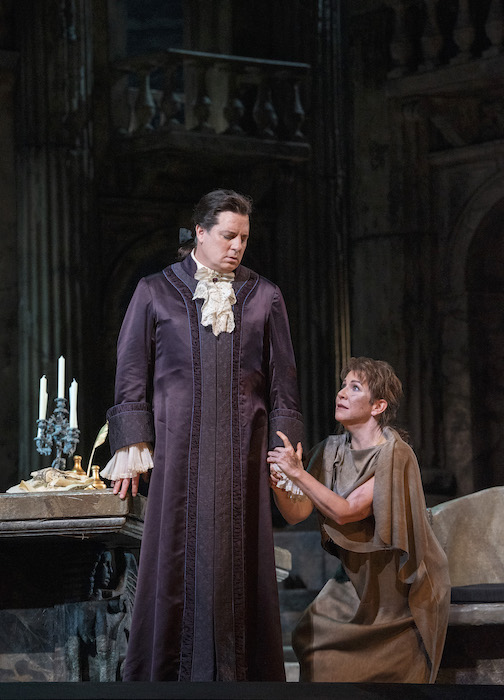Met’s supreme cast makes a royal case for Mozart’s “La Clemenza da Tito”

Matthew Polenzani and Joyce DiDonato in Mozart’s “La Clemenza di Tito” at the Metropolitan Opera. Photo: Jonathan Tichler
Mozart’s final opera, La Clemenza di Tito, is unusual in the context of his other late stage masterpieces. To begin, it is rarely presented—Wednesday night’s performance at the Metropolitan Opera (the current production opened Saturday) was only the 47th in the company’s history.
As an integrated music drama, La Clemenza is not on the same level as the three operas Mozart made with Lorenzo da Ponte. By the time of its premiere in 1791, the French Revolution had initiated the long decline of the European monarchies, yet here was a commission to celebrate the coronation of the new Holy Roman Emperor, Leopold II. Composed concurrently with Die Zauberflöte, La Clemenza di Tito was made specifically in the style of opera seria (which at the time was already archaic and out of fashion).
The story of the Roman Emperor Titus enduring and forgiving the worst kind of betrayal came from a libretto by Pietro Metastasio—adapted for Mozart by Caterino Mazzolà—that had already been set to music several dozen times. Its quality offers a substantial indication of what 18th century monarchs liked to imagine themselves to be—noble and beneficent beyond the measure of normal mortals.
The opera revolves around Tito (tenor Matthew Polenzani), the character designed by Metastasio to reflect a serene, bland goodness back at the monarch in the audience. Tito is so good as to be one-dimensional, and in Mozart’s version he doesn’t have the best music—that goes to all the women, including the trouser roles—and there’s little interesting in him as he struggles between being a beloved, noble ruler and a man of near saintly forbearance and empathy.
That made Polenzani’s compelling performance that much more impressive. The great beauty of his voice and his expressive phrasing added an unusual amount of weight to the role—he made the music sound so wonderful that his rhetoric alone created depth and meaning. From potential bathos Polenzani mined some real gems, especially in the Act II duet with Sesto that leads to the aria “Se all’impero.”
This was one of the strongest and deepest casts the Met has put on stage this season. Tito may be the title character, but the bulk of the drama involves his friend Sesto and Vitellia, Sesto’s beloved.
Polenzani’s singing was balanced with that of mezzo-soprano Joyce DiDonato, who sang Sesto. Like the tenor, she used a widely varied range of dynamics and articulation to shape her phrases. DiDonato is relatively small in stature, and her counterparts Annio (mezzo-soprano Emily D’Angelo) and Vitellia (soprano Elza van den Heever) towered over her physically, while her voice still dominated the space around her.
As Vitellia, the woman who feels so narcissistically scorned by Tito that she plots his death and manipulates Sesto into carrying out her plans, van den Heever was magnetic. The soprano sang with appreciable power that was only limited by a lightness in her lowest register. The rich color of her voice was also a terrific contrast with the glowing sweetness of soprano Ying Fang’s singing as Servilia. The D’Angelo/DiDonato couple pairing was also quite fine, the former’s boyish quality as Annio set against DiDonato’s darker instrument.
As Publio, bass-baritone Christian Van Horn sang with a precision that gave the character gravity and a clarity that expressed Mozart’s humane feeling toward his characters.
This revival of Jean-Pierre Ponnelle’s production dates all the way back to 1984, when James Levine championed the opera’s return. Ponnelle’s view accepts the story as corny, even by the standards of taste in 1791, effectively underplaying the thin drama while coloring the music. The vast set design shows the Roman Empire as imagined by monarchs of the late 18h century, with Piranesi-esque touches of sublime decay that comment on the type of rulers who felt validated by ancient clichés, a smart and subtle satire through sly visuals.
Mozart seems constrained by the formal limits of opera seria,
and the quality of the music in La Clemenza is uneven, by his standards. This is most true of the recitatives, which throughout the opera have little in the way of emotional or harmonic dynamism.
Near the end of Act I, there is a duet between Vitellia and Sesto, in which the argue over assassinating Tito, leading to Sesto’s great aria “Parto, parto, ma to,” which includes a unique basset horn obligato. It is at this point where Mozart seems to forget about what he is supposed to write and lets his genius at characterization through musical beauty return. This was where DiDonato’s performance really blossomed, and in the ensembles and solos in the second act she shaped everything with a powerful emotional transformation.
With Lothar Koenigs in the pit, the playing of the MET Orchestra was smooth and fluent but never as colorful or as crackling as Mozart should be. The continuo playing was surprisingly wan, though clarinetist Inn-Hyuck Cho played the obbligatos with a vivid sense of freedom.
La Clemenza di Tito runs through April 20. metopera.org






